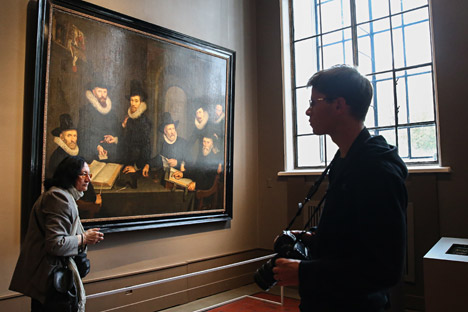
Group portraits reflected the aspirations and ideals of Dutch civil society in the 16th and 17th centuries. Source: ITAR-TASS
The exposition was prepared by the Amsterdam Museum, whose collection today includes dozens of such works (a total of about 125 group portraits have survived). The 10 large-scale paintings from the 16th and 17th centuries that arrived in Moscow rarely leave the confines of the Amsterdam Museum.
"Of course, the most famous work of this genre is ‘The Night Watch’ by Rembrandt. However, it is at the Rijksmuseum, and we have not managed to bring it here," says Normert Middelkoop, the curator of the exhibition on the Dutch side. "However, the Amsterdam Museum stores some group portraits by major artists of the same era, many of whom were contemporaries or pupils of Rembrandt. Their paintings of other genres form parts of the collections of the Pushkin State Museum of Fine Arts and the Hermitage."
The exhibition presents, for example, work by the painter and Rembrandt pupil Govert Flinck—portraits of riflemen from an Amsterdam shooting company have been placed on a 16-foot canvas. The other work is a more intimate but no less spectacular portrait of the regents of a female workhouse, painted by Bartholomeus van der Helst—an artist respected in his time no less than Rembrandt.
"These are the two most characteristic types of composition. While most paintings in Catholic Europe were commissioned by the church, artists in Protestant Holland of the 16th century were being turned to mainly by shooting companies and guilds, and, in the 18th century, they were joined by various charitable organizations," says Vadim Sadkov, the curator of the exhibition from the Russian side and head of the Old Masters Division of the Pushkin State Museum of Fine Arts.
Group portraits reflected the aspirations and ideals of Dutch civil society in the 16th and 17th centuries and have become the visual embodiment of the values and social status of a burgher. Each person portrayed paid the artist for his image; therefore, any portrait features all members of the group in a visible place, with no one overshadowing another.
Traditionally, administrators of charities and benefactors are depicted in severe black clothes, performing their official activities. Riflemen of the three shooting corporations of Amsterdam—archers, arbalesters and harquebusiers—are usually shown preparing to march out, at a formal meeting, or at the holiday table.
Portraits of officials of guilds are always equipped with attributes of their professional activities, as in the group portrait of the guild of coopers who made barrels, painted by Gerbrand van den Eeckhout. Members of this guild monitored the compliance of beer, soap and herring containers with standards; the artist placed a barrel and a large copper vessel in the foreground of the painting.
These little things and details can tell observers a lot about the characters depicted on the canvas and about the historical period. "I especially like to take a good look at clothes, hairstyles, details of everyday life and various details peculiar to that epoch," Yevgenia, a visitor of the exhibition, said, sharing her impressions.
"It would be great to make an interactive program that would enable visitors to insert their faces into these portraits. This is a carnival idea, of course, but it would allow the public to try on specifics of life, as if it was centuries ago, and to keep these experiences in their memories," Yevgenia’s companion, Svetlana, said.
Mondrian: From abstract modern art to IKEA
Dutch contemporary design comes to St. Petersburg
Peter the Great: Hermitage exhibition attracts people in Amsterdam
Especially for those interested in everyday life in the Netherlands at that time, the exhibition has been supplemented by several showcases with weapons from the 18th century, which were provided for the exhibition by the Armory Chamber of the Moscow Kremlin. In addition, some information screens have been installed in the hall, where the history of individual elements and objects in the paintings can be learned with just a few clicks.
"These technologies make the exhibition more modern, interactive—more comfortable for young people and all those for whom computer technologies are a natural part of life," said director of the Pushkin State Museum of Fine Arts, Marina Loshak.
“The Dutch Group Portrait of the Golden Age” exhibition will run until the middle of January 2014.
All rights reserved by Rossiyskaya Gazeta.
Subscribe
to our newsletter!
Get the week's best stories straight to your inbox